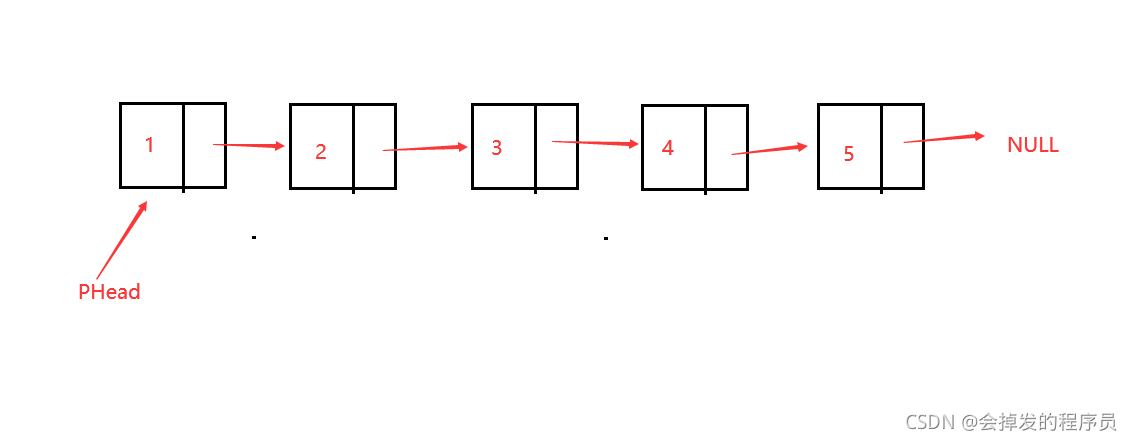这篇文章将为大家详细讲解有关C语言链表有什么用,小编觉得挺实用的,因此分享给大家做个参考,希望大家阅读完这篇文章后可以有所收获。
链表是一种物理存储结构上非连续、非顺序的存储结构,数据元素的逻辑顺序是通过链表中的指针链接次序实现的 。
代码
struct Slist
{
int* a;
struct Slist* next;
};逻辑结构:

物理结构:

注意:
从上图可以看出,链式结构在逻辑上是连续的,但是在物理上是不一定是连续的。
这些结点一般是从堆上申请出来的。
从堆上申请的空间,是按照一定的策划来分配的,两次申请的空间可能连续,大概率是不连续的。
实际中链表的结构非常多样,以下情况组合起来就有8种链表结构:
1. 单向或者双向
①单向

②双向

2.带头或者不带头
①带头

②不带头

3.循环或者非循环
①循环

②非循环

虽然有这么多种结构的链表,但是我们实际中最常用的只有两种结构:
1. 无头单向非循环链表

2.带头双向循环链表

1. 无头单向非循环链表:结构简单,一般不会单独用来存数据。实际中更多是作为其他数据结构的子结构,如哈希桶、图的邻接表等等。另外这种结构在笔试面试中出现很多。
2. 带头双向循环链表:结构最复杂,一般用在单独存储数据。实际中使用的链表数据结构,都是带头双向循环链表。另外这个结构虽然结构复杂,但是使用代码实现以后会发现结构会带来很多优势,实现反而简单了,后面我们代码实现了就知道了。
单链表结构
typedef int SLTDateType;
typedef struct SListNode
{
SLTDateType data;
struct SListNode* next;
}SListNode;单链表需要的功能
// 动态申请一个节点 SListNode* BuySListNode(SLTDateType x); // 单链表打印 void SListPrint(SListNode* plist); // 单链表尾插 void SListPushBack(SListNode** pplist, SLTDateType x); // 单链表的头插 void SListPushFront(SListNode** pplist, SLTDateType x); // 单链表的尾删 void SListPopBack(SListNode** pplist); // 单链表头删 void SListPopFront(SListNode** pplist); // 单链表查找 SListNode* SListFind(SListNode* plist, SLTDateType x); // 单链表在pos位置之后插入x // 分析思考为什么不在pos位置之前插入? void SListInsertAfter(SListNode* pos, SLTDateType x); // 单链表删除pos位置之后的值 // 分析思考为什么不删除pos位置? void SListEraseAfter(SListNode* pos); // 单链表的销毁 void SListDestory(SListNode** pplist);
功能实现
SListNode* BuySListNode(SLTDateType x)
{
SListNode* newnode = (SListNode*)malloc(sizeof(SListNode));
if (newnode == NULL)
{
exit(-1);
}
newnode->data = x;
return newnode;
}
void SListPrint(SListNode* plist)
{
if (plist == NULL)
{
printf("NULL\n");
return;
}
else
{
while (plist)
{
printf("%d->", plist->data);
plist = plist->next;
}
printf("NULL\n");
}
}
void SListPushBack(SListNode** pplist, SLTDateType x)
{
SListNode* tail = *pplist;
SListNode* newnode = BuySListNode(x);
newnode->next = NULL;
if (tail == NULL)
{
*pplist = newnode;
}
else
{
while (tail->next)
{
tail = tail->next;
}
tail->next = newnode;
}
}
void SListPushFront(SListNode** pplist, SLTDateType x)
{
SListNode* newnode = BuySListNode(x);
newnode->next = *pplist;
*pplist = newnode;
}
void SListPopBack(SListNode** pplist)
{
assert(*pplist);
SListNode* tail = *pplist;
SListNode* Pretail = NULL;
if (tail->next == NULL)
{
*pplist = NULL;
return;
}
else
{
while (tail->next)
{
Pretail = tail;
tail = tail->next;
}
free(tail);
tail = NULL;
Pretail->next = NULL;
}
}
void SListPopFront(SListNode** pplist)
{
assert(*pplist);
SListNode* front = *pplist;
*pplist = front->next;
free(front);
front = NULL;
}
SListNode* SListFind(SListNode* plist, SLTDateType x)
{
assert(plist);
SListNode* pos = plist;
while (pos && pos->data != x)
{
pos = pos->next;
}
return pos;
}
void SListInsertAfter(SListNode* pos, SLTDateType x)
{
assert(pos);
SListNode* newnode = BuySListNode(x);
newnode->next = pos->next;
pos->next = newnode;
}
void SListEraseAfter(SListNode* pos)
{
assert(pos);
assert(pos->next);
SListNode* node = pos->next;
pos->next = node->next;
free(node);
}
void SListDestory(SListNode** pplist)
{
SListNode* node = *pplist;
SListNode* PreNode = NULL;
while (node)
{
PreNode = node->next;
free(node);
node = PreNode;
}
}双向链表的结构
SListNode* BuySListNode(SLTDateType x)
{
SListNode* newnode = (SListNode*)malloc(sizeof(SListNode));
if (newnode == NULL)
{
exit(-1);
}
newnode->data = x;
return newnode;
}
void SListPrint(SListNode* plist)
{
if (plist == NULL)
{
printf("NULL\n");
return;
}
else
{
while (plist)
{
printf("%d->", plist->data);
plist = plist->next;
}
printf("NULL\n");
}
}
void SListPushBack(SListNode** pplist, SLTDateType x)
{
SListNode* tail = *pplist;
SListNode* newnode = BuySListNode(x);
newnode->next = NULL;
if (tail == NULL)
{
*pplist = newnode;
}
else
{
while (tail->next)
{
tail = tail->next;
}
tail->next = newnode;
}
}
void SListPushFront(SListNode** pplist, SLTDateType x)
{
SListNode* newnode = BuySListNode(x);
newnode->next = *pplist;
*pplist = newnode;
}
void SListPopBack(SListNode** pplist)
{
assert(*pplist);
SListNode* tail = *pplist;
SListNode* Pretail = NULL;
if (tail->next == NULL)
{
*pplist = NULL;
return;
}
else
{
while (tail->next)
{
Pretail = tail;
tail = tail->next;
}
free(tail);
tail = NULL;
Pretail->next = NULL;
}
}
void SListPopFront(SListNode** pplist)
{
assert(*pplist);
SListNode* front = *pplist;
*pplist = front->next;
free(front);
front = NULL;
}
SListNode* SListFind(SListNode* plist, SLTDateType x)
{
assert(plist);
SListNode* pos = plist;
while (pos && pos->data != x)
{
pos = pos->next;
}
return pos;
}
void SListInsertAfter(SListNode* pos, SLTDateType x)
{
assert(pos);
SListNode* newnode = BuySListNode(x);
newnode->next = pos->next;
pos->next = newnode;
}
void SListEraseAfter(SListNode* pos)
{
assert(pos);
assert(pos->next);
SListNode* node = pos->next;
pos->next = node->next;
free(node);
}
void SListDestory(SListNode** pplist)
{
SListNode* node = *pplist;
SListNode* PreNode = NULL;
while (node)
{
PreNode = node->next;
free(node);
node = PreNode;
}
}双向链表的功能
//创建链表返回头结点 LTNode* ListInit(); // 双向链表销毁 void ListDestory(LTNode* phead); // 双向链表打印 void ListPrint(LTNode* phead); // 双向链表尾插 void ListPushBack(LTNode* phead, LTDateType x); // 双向链表尾删 void ListPopBack(LTNode* phead); // 双向链表头插 void ListPushFront(LTNode* phead, LTDateType x); // 双向链表头删 void ListPopFront(LTNode* phead); // 双向链表查找 LTNode* ListFind(LTNode* phead, LTDateType x); // 双向链表在pos的前面进行插入 void ListInsert(LTNode* pos, LTDateType x); // 双向链表删除pos位置的节点 void ListErase(LTNode* pos);
功能实现
LTNode* ListInit()
{
//哨兵位头结点
LTNode* phead = (LTNode*)malloc(sizeof(LTNode));
if (phead == NULL)
{
printf("开辟空间失败!!!\n");
exit(-1);
}
phead->next = phead;
phead->prev = phead;
return phead;
}
void ListDestory(LTNode* phead)
{
assert(phead);
LTNode* cur = phead;
LTNode* p = NULL;
LTNode* tail = phead->prev;
while (cur != tail)
{
p = cur;
cur = cur->next;
free(p);
}
free(tail);
}
void ListPrint(LTNode* phead)
{
assert(phead);
LTNode* front = phead->next;
while (front != phead)
{
printf("%d ", front->data);
front = front->next;
}
printf("\n");
}
void ListPushBack(LTNode* phead, LTDateType x)
{
assert(phead);
LTNode* tail = phead->prev;
LTNode* newnode = (LTNode*)malloc(sizeof(LTNode));
if (newnode == NULL)
{
printf("开辟空间失败!!\n");
exit(-1);
}
newnode->data = x;
tail->next = newnode;
newnode->prev = tail;
newnode->next = phead;
phead->prev = newnode;
}
void ListPopBack(LTNode* phead)
{
assert(phead);
assert(phead != phead->next);
LTNode* tail = phead->prev;
LTNode* TailFront = tail->prev;
TailFront->next = phead;
phead->prev = TailFront;
free(tail);
}
void ListPushFront(LTNode* phead, LTDateType x)
{
assert(phead);
LTNode* next = phead->next;
LTNode* newnode = (LTNode*)malloc(sizeof(LTNode));
if (newnode == NULL)
{
printf("开辟空间失败!!\n");
exit(-1);
}
newnode->data = x;
phead->next = newnode;
newnode->prev = phead;
newnode->next = next;
next->prev = newnode;
}
void ListPopFront(LTNode* phead)
{
assert(phead);
assert(phead != phead->next);
LTNode* head = phead->next;//头结点
phead->next = head->next;
head->next->prev = phead;
free(head);
}
LTNode* ListFind(LTNode* phead, LTDateType x)
{
assert(phead);
LTNode* cur = phead->next;
while (cur != phead)
{
if (cur->data == x)
{
return cur;
}
cur = cur->next;
}
return NULL;
}
void ListInsert(LTNode* pos, LTDateType x)
{
assert(pos);
LTNode* posPrev = pos->prev;
LTNode* newnode = (LTNode*)malloc(sizeof(LTNode));
if (newnode == NULL)
{
printf("开辟空间失败!!\n");
exit(-1);
}
newnode->data = x;
posPrev->next = newnode;
newnode->prev = posPrev;
newnode->next = pos;
pos->prev = newnode;
}
void ListErase(LTNode* pos)
{
assert(pos);
LTNode* posPrev = pos->prev;
LTNode* posNext = pos->next;
posPrev->next = posNext;
posNext->prev = posPrev;
free(pos);
}关于“C语言链表有什么用”这篇文章就分享到这里了,希望以上内容可以对大家有一定的帮助,使各位可以学到更多知识,如果觉得文章不错,请把它分享出去让更多的人看到。
免责声明:本站发布的内容(图片、视频和文字)以原创、转载和分享为主,文章观点不代表本网站立场,如果涉及侵权请联系站长邮箱:is@yisu.com进行举报,并提供相关证据,一经查实,将立刻删除涉嫌侵权内容。